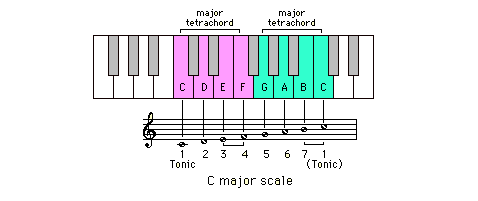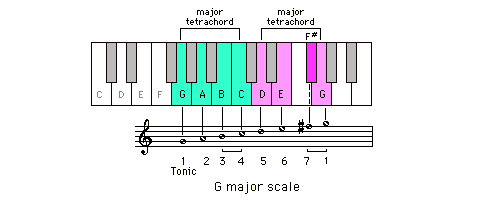|
The Major Scale
::

|
Key words:
major scale
chromatic scale
key note
degree
Roman numerals |
| 1 |
The Major Scale
Lesson 25
details the origins of the Western scale.
This lesson concentrates on what a
major scale
is, and how starting from any of the twelve
notes
in the
chromatic scale
one derives the twelve
major scales.
|
|
|
|
|
|
|
|
|
|
|
|
|
|
|
|
|
|
|
|
|
|
|
|
|
|
|
|
|
|
|
|
|
|
|
|
|
|
|
|
|
|
|
|
|
|
|
|
|
|
|
|
|
|
|
|
|
|
|
|
|
|
|
|
|
|
|
|
|
|
|
|
|
|
|
|
|
|
|
|
|
|
|
|
|
|
|
|
|
|
|
|
|
|
|
|
|
|
|
|
|
|
|
|
|
|
|
|
|
|
|
|
|
|
|
|
|
|
|
|
|
|
|
|
|
|
|
|
|
|
|
|
|
|
|
|
|
|
|
|
|
|
|
|
|
|
|
|
|
|
|
|
|
|
|
|
|
|
|
|
|
|
|
|
|
|
|
|
|
|
|
|
|
|
|
|
|
|
|
|
|
|
|
|
|
|
|
C
|
|
D
|
|
E
|
|
F
|
|
G
|
|
A
|
|
B
|
|
*
C
|
|
D
|
|
E
|
|
F
|
|
G
|
|
A
|
|
B
|
|
C
|
|
D
|
|
E
|
|
F
|
|
G
|
|
A
|
|
B
|
|
Examine the keyboard again. Starting from the key marked middle C (that is, the key C with an asterisk), play the
naturals
(i.e. the white keys) in ascending order, C, D, E, F, G, A, B and finish on the C above middle C. This sequence or row of eight
notes
is the C major scale, the
major scale
for which the
key-note
is C. Music written using the
notes
of this
scale
is said to be '
in the key of C
'. The different notes are called the
degrees
of the scale such that the
key note, C, is called the 'first degree of the scale', D is the 'second degree of the scale', and so on.
The eight degrees of the scale may be numbered using 1 - 8 or Roman numerals I - VIII (i.e. I, II, III, IV, V, VI, VII, VIII) or i - viii (i.e. i, ii, iii, iv, v, vi, vii, viii).
What makes this a
major scale
is the distinctive sequence of tones (whole steps) and semitones (half steps). If we write down the
intervals
between the
notes
rather than the note names then the C major scale becomes
tone-tone-semitone-tone-tone-tone-semitone, seven
intervals
between eight
notes.
If you play any other ascending row of eight consecutive
naturals
you will find many different sequences of
intervals. C major is the only
major scale, that is a scale obeying the interval sequence
tone-tone-semitone-tone-tone-tone-semitone, using only the white keys.
In 'whole step-half step' notation this sequence is written
whole step - whole step - half step - whole step - whole step - whole step - half step.
|
|
|
The Tetrachord
::

|
Key words:
tetrachordon
tetrachord |
| 1 |
The Tetrachord
There is another way of looking at the
major scale. It is derived from a pattern of four
notes
called the
tetrachord
(Greek:
tetra
= four,
chorde
= string or note: originally from
tetrachordon, an ancient Greek four-stringed instrument). The ancient Greeks applied the term originally to a falling sequence of four notes with a number of patterns including the interval pattern
tone - tone - semitone. Today, we use the term to mean a rising sequence of four notes including that using the interval pattern
tone - tone - semitone. The word
tetrachord
can be applied to the interval, a perfect fourth, between the first and last note of the four note sequence as well as to all the notes in the sequence itself.
The C major scale is in fact two
tetrachords, one after the other, separated by a tone, in which case the two tetrachords are said to be combined by disjunction. Thus:
C - tone - D - tone - E - semitone - F
: the first
tetrachord
G - tone - A - tone - B - semitone - C
: the second
tetrachord
The interval between
F, the last note of the first
tetrachord, and
G, the first note of the second
tetrachord, is a
tone.

If we start on G, to produce the G major scale, the pattern will be
G - tone - A - tone - B - semitone - C
: the first
tetrachord
D - tone - E - tone - F# - semitone - G
: the second
tetrachord
The interval between
C, the last note of the first
tetrachord, and
D, the first note of the second
tetrachord, is a
tone and so again the two tetrachords are said to be combined by disjunction.

|
|
|
The Twelve Major Scales
::

|
Key words:
major scales
sharp key
flat key
natural key |
| 1 |
The Twelve Major Scales
We return to the chromatic scale starting on middle C which has been written twice: on the upper line with only naturals and flats and on the lower line with only naturals and sharps. Both scales 'play' the same row of
notes.

| by convention the major scales are divided into three groups: |
| the 'sharp' keys | G major, D major, A major, E major, B major, F sharp major, C sharp major |
| all the 'sharp' scales that employ black keys, use that key's 'sharp' name |
| in some 'sharp' keys, you may have to use E sharp and/or B sharp |
| the 'natural' key | C major - which uses only the white keys |
| the 'flat' keys | F major, B flat major, E flat major, A flat major, D flat major, G flat major, C flat major |
| all the 'flat' scales that employ black keys, use that key's 'flat' name |
| in some 'flat' keys, you may have to use F flat and/or C flat |
| in addition there are two other points worth remembering: |
the degrees I to VII of any major or minor scale must have different 'letter' names
thus, A (whether flat, natural or sharp), B (whether flat, natural or sharp), and so on, can only appear once in any major or minor scale |
| only naturals, sharps and flats may be used when notating major scales although double sharps can appear in certain minor scales. Mark Pfannschmidt points out that double flats appear in none of the standard major or minor scales |
|
|
|
Deriving Major Scales
::

|
Key words:
building major scales
key signature |
| 1 |
Deriving Major Scales
Using the distinctive
major scale
interval sequence,
tone-tone-semitone-tone-tone-tone-semitone
we can construct each of the scales in turn. We have provided two 'worked examples' below.
Let us examine first one of the 'sharp'
scales, the '
A major scale
'.
|
degree of scale
|
note
|
interval to add
|
resultant note
|
|
1
|
A
|
tone or whole step
|
B
|
|
2
|
B
|
tone or whole step
|
C sharp
|
|
3
|
C sharp
|
semitone or half step
|
D
|
|
4
|
D
|
tone or whole step
|
E
|
|
5
|
E
|
tone or whole step
|
F sharp
|
|
6
|
F sharp
|
tone or whole step
|
G sharp
|
|
7
|
G sharp
|
semitone or half step
|
A
|
Notice that we have used C sharp rather than D flat to avoid using D twice in the scale. Similarly F sharp and G sharp must be chosen in preference to their enharmonic names G flat and A flat.
We have laid out the
A major scale
on the
treble clef
below, the upper line showing the
notes
themselves, missing only superfluous
natural
signs, and the lower line showing how, by using a
key signature, (the three sharps displayed on the left hand side of the stave), the sharp signs are 'understood' and need not be displayed again within the score. You will notice that the three sharp signs in the
key signature
mirror the three sharps in the scale on the upper line.

And now, let us derive one of the 'flat'
scales, the '
E flat major scale
'.
|
degree of scale
|
note
|
interval to add
|
resultant note
|
|
1
|
E flat
|
tone or whole step
|
F
|
|
2
|
F
|
tone or whole step
|
G
|
|
3
|
G
|
semitone or half step
|
A flat
|
|
4
|
A flat
|
tone or whole step
|
B flat
|
|
5
|
B flat
|
tone or whole step
|
C
|
|
6
|
C
|
tone or whole step
|
D
|
|
7
|
D
|
semitone or half step
|
E flat
|
Again we have chosen flat names rather than their enharmonic sharp names to satisfy the requirement than all note letter names be different.
We have laid out the
E flat major scale
on the
treble clef
below, the upper line showing the
notes
themselves, missing only superfluous
natural
signs, and the lower line showing how, by using a
key signature, (the three flats displayed on the left hand side of the stave), the flat signs are 'understood' and need not be displayed again within the score.

|
|
|
Chart of the Major Scale
::

|
Key word:
chart of major scales |
| 1 |
Chart of the Major Scale
In the next lesson we will examine the way
key signatures
are used and the 'conventions' associated with the use of 'natural', 'sharp' and 'flat' signs.
|
|
 :: next lesson :: next lesson
|
|
 :: next lesson
:: next lesson




